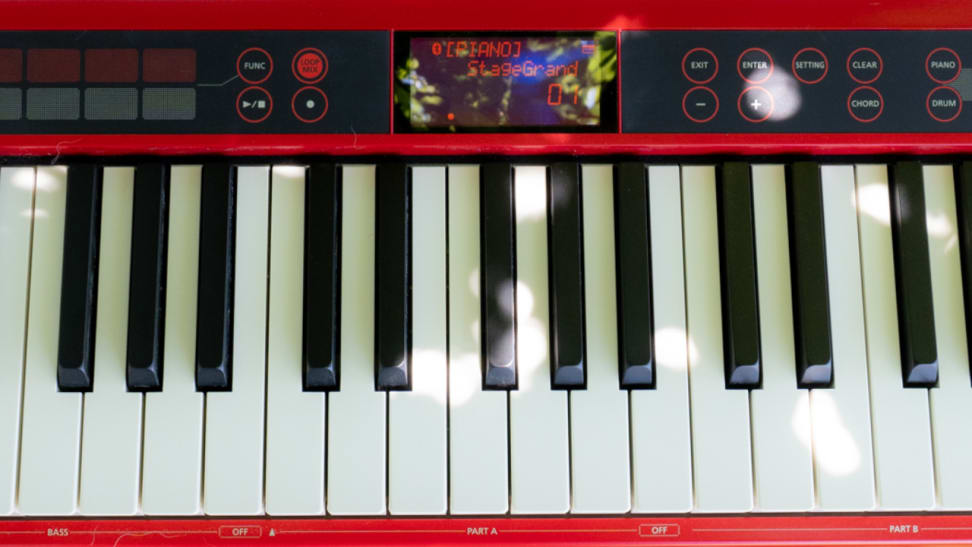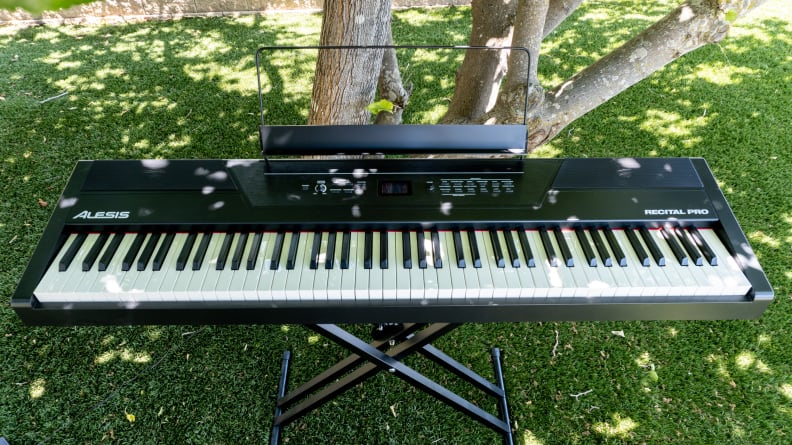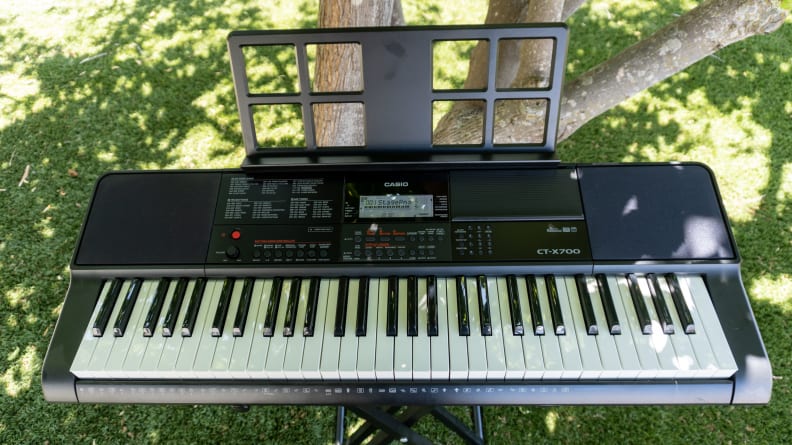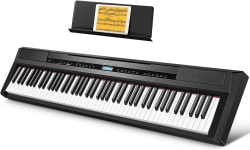
The Best Keyboard Pianos for Beginners of 2021
Share
 — Recommendations are independently chosen by Reviewed’s editors. Purchases you make through our links may earn us a commission.
— Recommendations are independently chosen by Reviewed’s editors. Purchases you make through our links may earn us a commission.From the pop singles streamed into our earbuds to the scenes of movies and television shows pushed to the next level by a soaring soundtrack, music permeates our lives. So, it’s no wonder that many of us decide to stop being a bystander and learn an instrument.
For many that means the piano: a row of 88 keys that is the genesis point of most of the music we hear today. While lugging a baby grand into your house on a whim seems foolish, picking up an inexpensive keyboard with tutorials built-in or available via companion apps is a great way to get you started with tickling the ivories.
After weeks of research and testing the top keyboards on the market, we can tell you that the Alesis Recital Pro (available at Sweetwater) is the best piano keyboard for beginners. At a price point far below a traditional piano, it delivers the sound and key feel of the analog instrument in a sturdy easy to use package.
For those hoping to jump into the music on a budget, the Casio CT-X700 (available at Amazon) offers great sound and a superb tutorial app.
Here are the best piano keyboards for beginners we tested ranked, in order:
- Alesis Recital Pro
- Casio CT-X700
- Donner DEP-20
- Casio LK-S250
- Roland Go Piano 88
- Yamaha PSR 373
- Playground Sessions PG-150
- Yamaha EXZ 300
- Roland Go Keys 61K
- Yamaha Remie PSS-E30


The Alesis Recital Pro is an excellent keyboard for beginners that will still be a joy to play as their musical skills progress.
For the best learning experience, it’s hard to argue with the 88-key Alesis Recital Pro. Right out of the box, the Recital Pro impressed with its sturdiness and build quality. The Alesis was the best sounding keyboard of the models we tested, nearly recreating the authentic sounds of an actual piano. The keyboard’s hammer-action weighted keys will help beginners transition to a traditional piano, if they so desire, without issue. That the keys can be adjusted to increase or reduce the keyboard’s feedback allows for a customizable playing experience, with feedback that can be tinkered with, at the drop of a hat.
The Recital Pro’s controls are straightforward. The number of physical buttons are kept to a minimum in an effort to keep new students from becoming overwhelmed by the number of features on offer. There are 11 additional voices (instrument sounds) available in the Recital Pro. All are easily accessible through the keyboard’s buttons with either a single or double-tap. While this might not be as many sounds as other keyboards in this guide offer, the Recital Pro makes up for it by making its sound options so easy to work with and, by ensuring that each of the 11 available sounds professional grade.
The instrument's ability to split the keyboard in two creating essential two 44-key pianos from a single 88-key keyboard means that an instructor can help demonstrate a lesson while the student follows along. Digital tutorials though are handled by third parties. Alesis offers three months of Skoove Premium tutorials for free and two months of TakeLessons video lessons for free with the purchase of the keyboard.
The Alesis offers left and right ¼ audio out (the industry standard for professional headphones and other audio devices) for recording and using an amplifier that leaves the internal speakers on for monitoring. For quiet, a separate ¼ headphone output is available so students can practice without the internal speakers annoying others in the household. It supports USB MIDI ( a decades-old digital interface) and has a ¼ port for a sustain pedal (a compact. Plug-in replacement for the sustain pedals found on a piano) although that must be purchased separately.
For beginning and seasoned pianists, the Alesis Recital Pro offers nearly everything they need to take their playing to the next level with a keyboard that’s built to last.
Pros
-
Weighted keys
-
Amazing sound through speakers or an amp
-
Excellent build quality
Cons
-
Tutorial outsourced
-
Tutorial requires monthly subscription


With its easy-to-use interface and a variety of tools to help budding musicians with their lessons, the Casio CT-X700 is a great choice.
The Casio CT-X700 is an amazing value. The 61-key keyboard comes with a huge library of sounds, touch-sensitive keys, and an easier-to-understand interface on the top of the keyboard that’s not completely overwhelming like offerings from other companies.
For beginners, the CT-X700 brings multiple ways to help them learn how to play and read music. The display houses a treble and bass clef image that indicates what key and its corresponding note are being played. For those learning to read music, it’s an easy way to quickly figure out where exactly they need to be on the keyboard.
Casio’s subscription-free Chordana Play companion app for iPhone and Android provides lessons on how to play songs. Unlike some free apps from other musical instrument makers, Chordana Play actually works as advertised. When playing a song it notes that students need to play fall, from the top of their smartphone or tablet’s screen, sort of like the video game Guitar Hero. It’s an easy-to-use app that also supports users importing MIDI files to play with and can connect with streaming audio services so students can play along to their favorite songs.
The sound quality of the CT-X700 voices is impressive for its price tag. The keyboard ships with 600 tones although most will likely be ignored in favor of more traditional instrument noises. On-board speakers are loud and clear enough to play even in noisy environments while audio sent through a keyboard amp sounded crisp and rich.
While the keys are not weighted, the quality of the keys should result in years of daily playing although the feedback isn’t as refined as offerings from Yamaha. Build quality overall should make the CT-X700 fine for transporting to events. The keyboard is light but doesn’t feel cheap. Also, there’s a little ledge below the music rest on the right side for your smartphone or small tablet because that’s the world we live in now.
For those dabbling into the world of piano and keyboards, the Casio CT-X700 offers up a ton of useful and easy-to-use features in a package that sounds great and won’t break the bank. It’s just enough keyboard to find out if you want to continue learning or you’re just happy making weird noises in your garage.
Pros
-
Solid tutorial companion app
-
On-keyboard display shows notation on scale
-
Easy to understand interface
Cons
-
Unimpressive battery life
How We Tested Piano Keyboards for Beginners

All of the keyboards in this guide were rigorously tested by a professional musician who conveniently happens to also be a journalist.
The Tester
I’m freelance journalist Roberto Baldwin and I’ve been covering musical instruments including keyboards, guitars, drum machines, and synths for nearly a decade. In that same amount of time, I’ve been in numerous bands (North American Scum, Drastic Cats, Pickle Horse) using instruments in live settings in various types of venues.
The Tests
Learning an instrument is a difficult endeavor. In many instances, students give up and walk away in frustration. So, before we started searching for keyboards to test, we capped the cost of anything we wanted to test at $400—a considerable amount of money, but a price that’s still obtainable, for most people. As we started to winnow down the keyboards in this price range that we wanted to test, we eliminated any that had an overwhelming amount of negative reviews. We also made it a priority to find a broad range of keyboards, offering various learning tools, to make sure we found something that works for a variety of students.
The keyboards called in for this guide had the following features assessed:
- Sound Quality: We tested the audio quality of each keyboard by churning out sound, both through their internal speakers and running through a professional keyboard amp.
- Key Quality: We evaluated the feedback and “feel” of each keyboard, including two that came equipped with weighted keys, which more closely resemble the action of keys on a piano.
- Battery Life: Nearly all the keyboards supported running off of battery therefore rundown test were conducted to see how long a person could practice before ordering more batteries. All the keyboards were set at medium volume and played music in demo mode until they shut down. All of them lasted far longer than anticipated but there was a large delta between the first set of keyboards to shut down and the second.
- User Experience: Because learning to play the piano is already difficult, we tested how easy each keyboards user interface was to use, taking into account the sometimes baffling number of buttons and settings on a modern keyboard as well as how easy it was to connect the device to a smartphone or tablet running a companion app.
- Educational System: We tested the tutorial systems that came with each of the keyboards to help determine which one works best for different types of learners. As part of this, we looked at how easy it was to enable a tutorial as well as how enticing or frustrating the system was to use.
- Build Quality: The structural integrity of each keyboard was checked to see how well these devices would handle being transported either in a house or to a recital or show. If the end game is playing in front of an audience, transportability is an important factor and can be determined by the torsion strength of the exterior.
What You Should Know About Buying Piano Keyboards
While we've presented the best piano keyboard options available today for inclusion in this guide, we understand if you'd rather do some comparative shopping of your own, in-store or online. Should you take this path, here's a few terms you should keep in mind:
Weighted Keys Vs. Non-Weighted Keys
For those looking for a more realistic representation of an actual piano, a weighted keyboard is likely what you are looking for. These instruments are typically more expensive than non-weighted keyboards, but the student has the benefit of experiencing the feeling of playing a piano with hammers and strings and the feedback that system creates.
Non-weighted keyboards might not have the benefit of recreating the interaction between fingers and keys from a piano. However, they are less expensive and, even though the feedback from the keys themselves isn’t as impressive, most modern keyboards recognize how hard a key is depressed and adjust the loudness of a note.
Sounds, Voices, Instruments, and Patches
Depending on the manufacturer, the terms sound, voices, and patches are, essentially, the digital instrument sounds stored in a keyboard. All keyboards ship with the usual piano sound but from there companies add additional instruments from organs, to guitars, to weird spaceship sounds. But while learning piano, you’ll likely stick to the tried and true piano sound for most of your lessons.
What is MIDI?
Created in 1983 MIDI (Musical Instrument Digital Interface) is an industry-standard that dictates how instruments interact with one another and with computers. The protocol can send and receive data about notes, tempo, and controls. Most electronic musicians rely on MIDI to keep their instruments in sync and to control instruments for songs. For our purposes, MIDI is used to read and write information about notes being played. So the notes you play on the keyboard are recognized by the companion app via a USB cable.
Other Piano Keyboards for Beginners We Tested

Donner DEP-20’s build and sound quality couldn’t quite match that of the our Best Overall pick, but this weighted 88-key keyboard does offer an impressive facsimile of a traditional piano. Where the Donner outshines the Alesis Recital Pro is in the additional sounds that the keyboard offers: 238 different tones, versus the Alesis’s 12. When someone is finished with their lessons on the DEP-20, they can have some fun trying out their skills with sounds ranging from grand piano to ukelele.
The DEP-20 is built solidly enough to survive casual abuse around your home or while it’s being transported to a recital. Its 25-watt speakers deliver an adequate representation of a piano that’s loud enough from the keyboard for practice and playing in front of a crowd, even if an amplifier isn’t available.
Pros
-
88-key hammer action keyboard
-
238 available tones
Cons
-
Tutorial features are sparse

For next-level tutorials that include a fun light show, the 61-key Casio Casiotone LK-S250 delivers. It supports the same tutorial companion app as the CT-X700 but in addition to an on-display layout of the keyboard, the LK-S250 also has keys that glow red to indicate where the player should place their fingers. Using light to help teach people how to play a song has been around for decades (I learned how to play “When the Saints Come Marching in” using the same method in the 80s), is a quick way to give new players the satisfaction of playing a song at a quicker pace and, potentially, give them a life-long desire to play the piano.
The LK-S250 moves away from the trend of placing a multitude of buttons and information on the face of the keyboard. Instead, the controls are slim down to just a few buttons up top and a scroll wheel which makes navigating the keyboard’s various sounds and functions a bit tricky. It has tip-top sound quality and the caliber of the build makes the LK-S250 a prime candidate for transporting the keyboard to other locations thanks in part to the handle that’s revealed when the music rest is removed.
Pros
-
Handle makes it easy to transport
-
Light up keys to guide learning.
Cons
-
Scroll wheel and button navigation feels dated

The 88-key full-size Roland Go Piano brings outstanding sound quality and battery life to the table with its use of six D-size batteries. Where things start to fall apart is Roland’s companion app and tutorials. The Piano Partner 2 iOS and Android app is largely a frustrating affair that’s incredibly buggy. On most occasions you need multiple taps to select something and getting it to pair with the keyboard was difficult if it even worked at all the and grey text on an off-white background is a bad decision for readability. Playing the Roland Go Piano is an enjoyable experience but still falls shy of the key feel of offers from Donner and Alesis. When lifted, the keyboard doesn’t feel as solidly constructed as other keyboards in its price range due to its light weight.
The button layout on the Go Piano's face is minimalistic and the ability to split the keyboard between two players makes it good for working with a tutor. Bluetooth MIDI support is also welcome, but it’s best used with other software besides the companion app.
Pros
-
Great sound
-
Solid-feeling non-weighted keys
Cons
-
Horrible companion app
-
Doesn’t feel solid enough for regular transportation.

The 61-key Yamaha PSR 373 can be a bit overwhelming for beginners to tackle. While its sounds quality is top-notch, its impressive selection of 622 voices and sounds is impressive, it's a lot of options for a new player to process. This could make learning how to play, using the PSR-373, pretty intimidating. The PSR 373’s companion app can only add to the frustration that piano students may endure while trying to learn how to play, using this keyboard. The app is a buggy mess: we were never able to actually purchase or load any songs using the MusicSoft Manager iOS app.
The PSR 373’s onboard Keys to Success tutorial system didn’t offer a better alternative to other systems out there. It’s not very intuitive especially for the tablet generation and it likely takes more time to learn how to use the system correctly than to learn a song. Of the keyboards tested for this guide, the PSR 373 tied for last place in our battery tests with the Casio CTX-700 and Yamaha EZ-300 at just shy of 6 hours of playing. We might be able to overlook this if this keyboard came with a power supply. But it doesn’t. So we can’t.
Despite all of the problems with the PSR 373, we did like its split-keyboard functionality, which is great for working with a tutor, in person.
Pros
-
Lots of high quality sounds
-
Split keyboard
Cons
-
Worthless companion app
-
Short battery life compounded
-
Power supply being sold separately

The 61-key Playground Sessions PG-150 has by far, the slickest tutorial app of any of the keyboards we tested for this guide. Playground Sessions was co-created by legendary producer Quincy Jones and featuring musician Harry Connick Jr, the PG-150 feels like the way to go when it comes to learning piano until you realize that the app works with nearly any keyboard that supports MIDI, which all of those in our test supports except for the Yamaha Remie PSS-E30.
Really the keyboard is just a piece of hardware built to support the tutorial application. While its $150 price tag is tempting, it’s subsidized by a subscription to the Playground Session app. Other than that, the hardware is middling, at best. The feel of its keys is lackluster compared to the rest of the keyboards in this guide.
While it may be inexpensive, for a bit more money you can get something better and still use the app.
Pros
-
Outstanding tutorial system
Cons
-
Tutorial system requires paid subscription
-
Mediocre hardware

Like the Yamaha PSR-373, the EXZ 300’s top user interface is a cavalcade of physical buttons and information—that’s overkill for a keyboard meant for beginners. Add to this the fact that the keyboard’s companion app is a horrible experience, due to its poor readability and difficulty to use.
What the EXZ 300 does have going for it, however, is its light-up keys, which help build confidence and skills as they work through the keyboard’s built-in tutorials. The EXZ 300’s keys glow red along in time with the tutorial song being played, making it easy for learners to play along. That said, the quality of the keys feels subpar when compared to the other piano keyboards we tested for this guide. However, the overall construction of the device lends itself to being dragged from location to location.
Unfortunately, the EXZ 300 ships without a power supply. What’s more, it tied for dead last in our battery rundown test.
Pros
-
Light-up keys make learning fun
-
Solid construction.
Cons
-
Information overload on face of device
-
Power supply not included
-
App experience is frustratingly bad

With its 80’s inspired design and loop mix function, the Go Keys 61K is best suited for those that already know how to play and will be connecting it to a sound system. For beginners, it doesn’t offer much in the way of tutorials. The Go Keys 61K falls apart when it comes to its awkwardly designed and buggy companion app, poor speaker quality and, its middle-of-the-road, non-weighted keys. Overall, however, the Go Keys 61K is one of the best-made piano keyboards we tested for this guide.
Pros
-
Solid construction
Cons
-
Sub-par sound
-
Horrible educational app experience.

It’s hard to dislike the tiny Yamaha Remie PSS-E30. It’s built for small hands, offers a variety of weird sounds including dogs, cats, helicopters, and explosions, and has a quiz mode that helps children learn notes by sound. But it’s less of a keyboard meant for serious education and more of a toy.
The sound coming out of the tiny speaker sounds like 70’s AM radio and the quality of its keys is meant more for repeated bashings than nuanced playing. Like the rest of the Yamaha products we tested for this guide, it ships without a power supply. However, you can power it using a USB port or charger, which is nice.
The Remie PSS-E30 doesn’t support MIDI or integration with tutorial apps. Its quiz mode is a great way to learn how to teach children to play by ear, but outside of that, this keyboard is better more of a fun toy to give to a child ahead of a proper music education.
Pros
-
Light-up keys make learning fun
-
Solid construction.
Cons
-
Information overload on face of device
-
Power supply not included
-
App experience is frustratingly bad